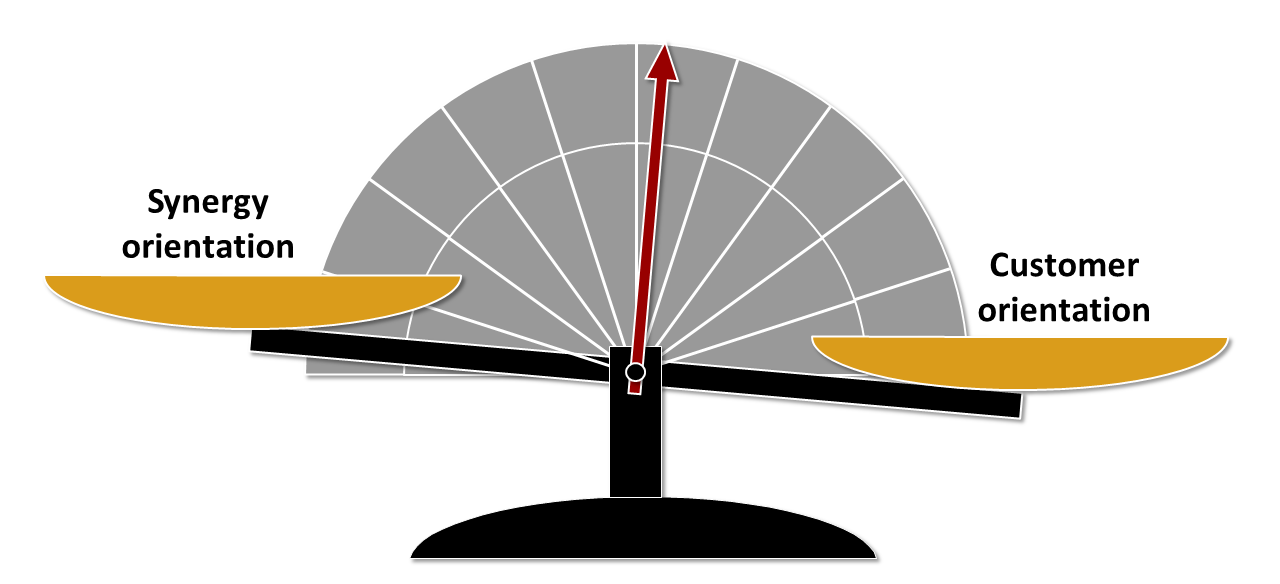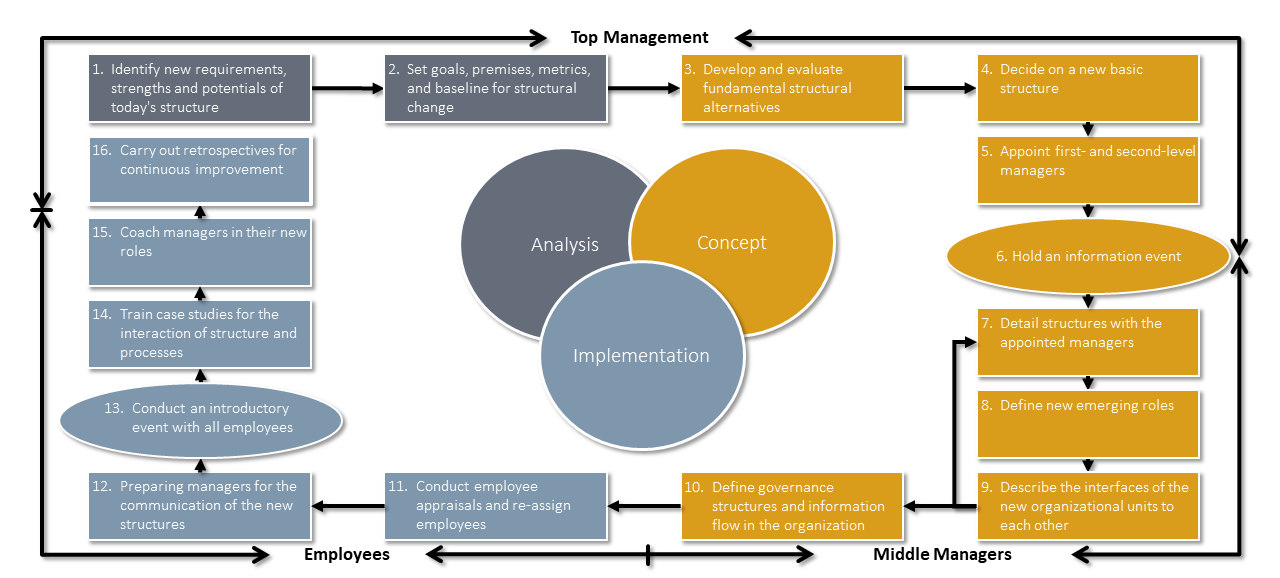Shaping the organisation
Organisational structures give a company stability and provide employees with clear orientation. But in times of the increasing speed of change and sudden disruptive upheavals, companies need more. In the future, companies that not only fulfil the basic requirements of a flexible and efficient organisation but which also have a high strategic adaptability and are managed in an agile manner, will, therefore, operate successfully in a VUCA world. We help you to develop your company into such a resilient organisation.
Resilient organisation
Resilience is the ability to survive difficult corporate situations without lasting impairment or even to anticipate them and react pro-actively. Resilient organisations are characterised by three main features:
- Strategic adaptability
- Agile leadership
- Operational flexibility and efficiency
Strategic adaptability
Resilient organisations increase their strategic adaptability by adopting a strategy that is more open to the future. This is achieved primarily through two capabilities:
- They supplement the strategy process, which has so far been strongly dominated by an analysis of the external corporate environment, with a core competence-based strategy determination from the inside out.
- They no longer see the future as a linear development that can be predicted, but rather think in terms of alternative scenarios.
More on this characteristic of a resilient organisation can be found here: Strategic adaptability.
Agile leadership and agile culture
Agile working at team level will ultimately only lead to greater market success for the company if the leadership of these teams is also based on agile, and thus trust-based, principles. Douglas McGregor postulated this as early as 1960 with his Theory X and Theory Y. Modern leaders focus less on leading their employees technically (expert leadership) or organising their work and motivating them with goals (Achiever Leadership). They focus on shaping the employees’ environment so that they can achieve the best results (Catalyst Leadership). In doing so, they have recognised that their employees are driven or motivated by three factors in particular:
- Purpose: I want to understand the purpose of my actions.
- Mastery: I want to learn and improve.
- Autonomy: I want to act on my own responsibility.
Catalyst Leaders know how to activate these three drivers of motivation and willingness to perform in their employees. They have also experienced that, in terms of the underlying market, customers or working methods applied, their employees adapt efficiently and deliver good results under operational conditions that are in constant flux, such as those caused by the Corona crisis, as long as these three drivers can be maintained in a strong form.
At an advanced stage, the organisational structure plays an important role in determining what framework is made available to managers for implementation. Ideally, the four dimensions of leadership are distributed among different managers. Product responsibility lies with the Product Owners (or comparable roles). Responsibility for the efficiency of the teams and the quality of collaboration lies with the Scrum Masters or Agile Coaches. The technical responsibility lies with the Technology Owners. And finally, the employee needs a disciplinary manager who takes over the administrative tasks. Under these conditions, an agile culture can ideally develop and take shape.
More on this characteristic of a resilient organisation can be found here: Anchor agility within your organisation.
Flexibility and efficiency
In addition to establishing strategic adaptability and agile leadership, organisations need to reconcile many divergent requirements, in order to achieve cost and speed advantages through high efficiency, on the one hand, and to react flexibly to changing market requirements or technology opportunities with a clear customer orientation, on the other. A task that is rendered even more difficult by globalisation, bottlenecks in the personnel markets and legal restrictions.
We create the necessary balance primarily through a multi-dimensional matrix organisation in which you find a healthy balance between market, product and customer orientation, on the one hand, and synergy orientation, on the other. In the process, balancing the scales requires constant effort. The organisation must always be adjusted and brought into a state of equilibrium.
In order to be able to deal with the increasing dynamics of markets and customer demands in the best possible way, you need a sufficient number of entrepreneurs in the company who take responsibility for markets and customers or products. You keep their organisational units lean, but let them be responsible for continuous end-to-end processes. In agile working methods, Portfolio Managers and Product Owners take on this role for the product development process.
In order to keep costs under control, but also to be able to fulfil new customer requirements quickly from a modular construction kit, you establish synergistic cross-sectional areas. In an agile organisation, these synergies are realised through communities of practice, known through Spotify as Chapters or Guilds. They counteract the dynamism of entrepreneurs and the striving for individual customer solutions with a desire for standardisation. This leads to a permanent conflict that is consciously brought about for the overall entrepreneurial optimum and must be moderated by management.
More on this characteristic of a resilient organisation can be found here: Flexibility and efficiency.
Global development network
If you have distributed your development resources globally, you need to organise their cooperation in an efficient global development network. Often, this network is still organically grown, lacking organisation, opaque and incomplete. With a clear role model and performance agreements, you can bring order to your network.
You can find more on this section here: Global Development Network.
Five tips from the field
- Strive for a healthy balance of market, product and customer focus, on the one hand, and synergy orientation on the other.
- Keep your companies lean within the organisation, but give them end-to-end process and product responsibility.
- In a matrix organisation, accept a conscious conflict for whose resolution the application of rules and involvement of leadership are needed.
- Recognise that the performance of your organisation depends largely on culture and leadership and work consistently on both.
- Balance the distribution of responsibilities globally to avoid a two-class society.
Twenty years of experience in organisational development
Our consultants have carried out several dozen reorganisation projects across industries. Therefore, we know how important it is to carry out restructuring quickly and in a targeted manner. This experience has been incorporated into a proven process model that systematically guides you through a reorganisation project.
As soon as you question your organisational structure for the first time, this information also trickles down to the employees. Unrest and uncertainty arise. Therefore, it is crucial to quickly arrive at positive interim results, to communicate these internally and to involve the staff in the structural design as early as possible.
In the first phase, the goals and premises for the reorganisation are defined. In the design phase, we first work out and evaluate fundamental structural alternatives together with senior management. Possible primary, secondary and tertiary structuring principles are played out in combination. We then subject the structure to further development directly with the responsible managers.
The design phase takes place in a clear top-down process. Change management is designed in such a way that middle and lower management, as well as employees, are involved in all changes that are relevant to them.
The benefit to you
- You increase the resilience of your organisation.
- You create a balance between customer and synergy orientation.
- You benefit from a validated process model.
- You involve managers and employees in the organisational design in the best possible way and thus achieve a high level of acceptance.
- We support you during implementation with communication measures and training.



